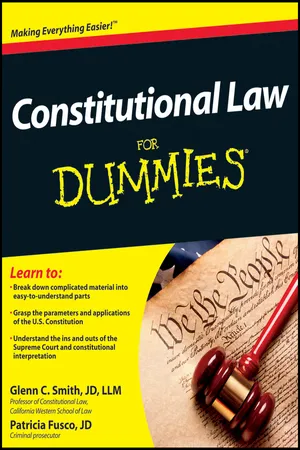Part I
Studying Constitutional Law: The Foundations
In this part . . .
The basis for constitutional law is the U.S. Constitution, and it has multiple facets. So before you approach learning about constitutional law, you need a foundation — you need to know what the Constitution aims to do. This part gives you that foundation, starting with a history of the document itself. Several chapters address its main aspects, and then we give you some details on key overall features so you can gain a better general understanding of the Constitution and related law. We also discuss where many people go astray in analyzing the Constitution so you won’t fall prey to common mistakes.
Chapter 1
Understanding the Constitution
In This Chapter
Summarizing the Constitution’s historical background
Taking a look at distinguishing characteristics of the Constitution
Appreciating the five components that make up the Constitution as a whole
Constitutional law is the study of how courts and other interpreters have given life and meaning to the United States Constitution. The Constitution and related law define the powers and limits of the national government — including how its three branches interact with each other and relate to state and local governmental authorities. Constitutional law also limits in many significant ways how governments at all levels interact with the people living within their boundaries. It protects key civil and criminal rights, including rights to avoid arbitrary and discriminatory treatment, protection for freedom of speech and religion, and guarantees of personal privacy.
In this book we explain the key details of constitutional law through summaries that make complicated legalese and technical details easily understandable and get right to the core of how the Constitution affects people in meaningful, practical ways. But before you delve into the specific topics in the following chapters, we give you an overview of that all-important document itself, the U.S. Constitution.
A country’s (or a state’s) constitution provides a framework for how governmental institutions will operate and how they will treat people. In a country like the United States, where the national constitution is the supreme legal authority, the U.S. Constitution becomes the yardstick against which to measure the validity of all other governmental actions — be they laws passed by Congress, the policies of local school boards, or the actions of an individual police officer.
Knowing a bit about the U.S. Constitution’s history and why and how certain clauses were put in the document in the first place will help you make sense of the ways it has been interpreted. For instance, you can better understand search-warrant requirements or checks and balances if you know why the framers thought to include them.
This chapter begins with a brief summary of the historical background leading up to the proposal in 1787 of the constitutional plan we still use today. This brief bit of context makes clear that the Constitution’s framers did not write on a clean slate — they started with what was already familiar, and they had specific ideas in mind as to what was needed. We then summarize nine key features making the U.S. Constitution distinct from the constitutions of other governments and even many other democracies. The last and most extensive section provides a tour of the five basic topics addressed by the various articles and amendments known collectively as the Constitution.
Looking at the Constitution’s Creation
Many volumes of history and political commentary address the historical background leading up to the proposal of a new governing arrangement in 1787. Scholars fiercely debate whether the framers of the U.S. Constitution were uniquely learned and inspired visionaries, reactionary elites bent on looking out for themselves rather than protecting the masses, or something in between. Lucky for you, you don’t need to know all the ins and outs of these ongoing discussions (though you may, like us, find them interesting if you look them up sometime).
Rather, to give you the essential historical perspective for understanding where the framers were coming from (which is an important factor in many areas of constitutional law), we present you with the following turbo- summary of the conventional account of the Constitution’s historical background — in 373 words:
During and after the American Revolution (whose hostilities ended in 1781), American leaders recognized that they needed some kind of overarching national authority to undertake key activities. For six years, the states functioned in a loose confederation under a document called the Articles of Confederation. Almost immediately, the defects of the Articles became apparent:
Each state had an equal vote in the legislative body operating under the Articles, which the states with the greater populations resented.
Laws resulting from the Articles reflected awkward political compromises, and the lack of any executive authority made effectively carrying out legislative directives difficult.
The government created by the Articles lacked taxing authority; it had to depend on voluntary financial contributions from states.
These defects couldn’t be easily remedied, because the Articles of Confederation said that all 13 states had to unanimously agree to make fundamental changes in governmental procedures.
Meanwhile, states began to act in ways that alarmed the country’s leaders. At times, inspired by popular uprisings, state legislatures interfered with the enforcement of debts and discriminated economically and legally against nonresidents. Some states engaged individually in foreign policy with England, France, and other powerful countries whose influence was feared by the leaders of the national government.
As disenchantment with the Articles of Confederation grew, states authorized delegates to meet to draft amendments. After an awkward start, the delegates at the 1787 Constitutional Convention ultimately decided to scrap the Articles of Confederation completely and instead propose a new Constitution, consisting of seven articles, for state ratification. Among other things, the new Constitution methodically responded in an almost checklist fashion to perceived defects in the Articles of Confederation. For example, the first power the framers gave to the new Congress was the power “To lay and collect Taxes.” And the new document explicitly forbade the states to “enter into any Treaty, Alliance, or Confederation.”
While they were at it, the framers also expressly forbade the new national government from engaging in many of the activities practiced by the despised English monarchy or their colonial representatives. As the following sections explain, the framers had certain specific areas of rights and governmental organization they felt needed to be addressed. They did so in pointed, though brief, fashion.
Understanding the Constitution’s Key Features
The U.S. Constitution has certain key features that distinguish it from the constitutions of other countries (or even, for some of its key features, from those of U.S. states). In general, you can split these features into three categories: characteristics of the document itself, features relating to government power, and features pertaining to rights of the people. Different observers may disagree about the number and relative importance of these features, but we think all the following aspects belong on the short list. (We discuss several of these features in detail in Chapter 4, which covers the structure of the federal government.)
Setting up the document
The way the U.S. Constitution positions itself, words its provisions, and provides for its amendment set it apart from many other constitutions around the world (and even from some state constitutions):
Constitutional supremacy: In the U.S., the provisions of the Constitution are the “supreme law of the land” and the ultimate benchmark for judging the validity of all laws adopted by Congress — and, indeed, all actions by government officials at the national, state, and local level.
Relatively few countries — and even relatively few democracies — give their constitutions that power. For example, although England and the other former commonwealth countries have deeply rooted democratic traditions and are moving toward constitutional supremacy as part of European Union membership, these countries still emphasize “parliamentary supremacy.” Under this theory, the laws passed by a country’s legislature are preeminent, and their legality or const...




